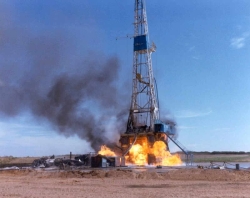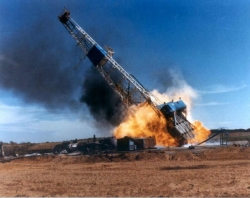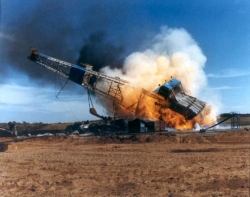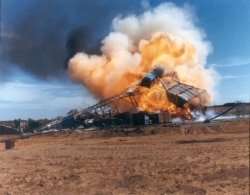|
|
Famous Gushers of the World
click any picture below for a larger view
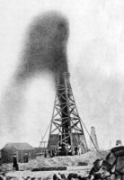 A "gusher" is an oil well that rages out of control, sending a column of oil into the sky. The British called them "spouters", and to the Russians they were "fountains". The official term seems to be "blow out", at least in the technical journals. All of the early oil regions - Baku, Pennsylvania, Romania/Poland, Texas, and California - had gushers, and the locals in all these areas, at one time or another, tried to lay claim to the title of having the world's greatest gusher. What follows is a sampling of some of the more famous gushers. This page looks at Famous Gushers of the world, but there is also a page on just the Famous Gushers of California.
A "gusher" is an oil well that rages out of control, sending a column of oil into the sky. The British called them "spouters", and to the Russians they were "fountains". The official term seems to be "blow out", at least in the technical journals. All of the early oil regions - Baku, Pennsylvania, Romania/Poland, Texas, and California - had gushers, and the locals in all these areas, at one time or another, tried to lay claim to the title of having the world's greatest gusher. What follows is a sampling of some of the more famous gushers. This page looks at Famous Gushers of the world, but there is also a page on just the Famous Gushers of California.
The spouter at left is the Nobel Brothers No. 25, which blew out at Balakhani field, Baku in 1883 at 500,000 *poods of oil daily (60,000 BOPD) from a depth of 582 feet.
*Russian oil was measured and sold by the pood, a unit of weight equal to 40 Russian pounds, which equates to 36.114 English pounds, with 8.33 poods to the standard 42-gallon oil barrel.
Spouters and Fountains of Baku
The Baku region of Azerbaijan was especially known for gushers, which the Russians called spouters and fountains. In fact, the practice of letting wells flow unchecked was encouraged, as it was realized that when the flow of a spouter was restrained, production went up in competing wells on neighboring leases. Thus, when flow from a spouter dropped, the competition got more oil and the spouter got less. However, when a spouter flooded the countryside in oil and buried it in sand, the owners of the well were responsible for the resulting property damage. Consequently, several spouters brought ruin to their owners when the flood of crude on the market dropped oil prices, and income from the well was not enough to compensate neighbors for the damage caused by the rain of sand and oil.
 The first big Baku spouter was drilled on the Balakhani plateau of the Apsheron Peninsula by the Khalifi Company in June 1873, when their Vermishev fountain raged out of control for four months. A huge cone of mud and sand formed around the well, down which rivers of oil flowed out across the entire field. The stalk of this spouter was still forty feet tall and nine feet in diameter two years later. The Vermishev was followed by the even bigger Kormilitza (Wet Nurse) spouter, and then the Soutchastniki spouter in 1875, both on the plateau, and the Orbelovi brothers' spouter in 1877 at Shaitan (Devil's) Bazaar. The first big Baku spouter was drilled on the Balakhani plateau of the Apsheron Peninsula by the Khalifi Company in June 1873, when their Vermishev fountain raged out of control for four months. A huge cone of mud and sand formed around the well, down which rivers of oil flowed out across the entire field. The stalk of this spouter was still forty feet tall and nine feet in diameter two years later. The Vermishev was followed by the even bigger Kormilitza (Wet Nurse) spouter, and then the Soutchastniki spouter in 1875, both on the plateau, and the Orbelovi brothers' spouter in 1877 at Shaitan (Devil's) Bazaar.
The most famous of the Baku spouters was drilled by the Droozhba (Friendship) Company, a small Armenian outfit that picked up a lease on the Balakhani plateau. Their well, which became known as the Droojba fountain, was drilled to a depth of 574 feet when it blew out on September 1, 1883 at a rate of 40,000 to 50,000 BOPD. The fountain spouted oil 200 to 300 feet into the air and raged out of control until it was capped on December 29, having produced an estimated 220,000 to 500,000 tons of oil (1.8 to 3.6 MMBO). Production was so great that oil prices plummeted and the owners of the well, instead of finding fame and fortune, were ruined by the ensuing litigation. Capping the well also caused "a great disturbance", presumed to be a flow increase, in the adjacent Nobel No. 14 well, proving the connection of both wells to the same oil compartment. The 350 ft oil column on the right is from a Baku gusher on the border of the Romany Lake.
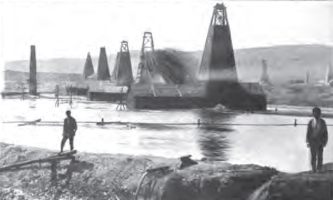 Although the Droozba fountain was huge, it was surpassed by a spouter drilled by the Tagiev (Tagieff) brothers near Bibi-Eibat, an embayment on the south side of the Apsheron Peninsula. The well was started in 1884 and yielded at its best 4,000 poods daily (480 BOPD). However, when deepened to 714 ft on September 27, 1886 it struck a new oil sand and spouted a column of oil 224 ft high with production of 30,000 poods (3600 BO) per hour. Maximum flow was reached on the 8th day when it flowed at 700,000 poods (84,000) per day - claimed in a 1905 history of Baku by James Dodd Henry to be more than the combined flow of all 25,000 wells in America and the thousands of wells in Romania. After the 10th day the flow began to diminish, and was controlled at 60,000 poods per day (7200 BOPD) by the 15th day. An estimated 12,000,000 poods (1.44 MMBO) were produced, most of which was lost in the Caspian sea. A Bibi-Eibat gusher is shown on the upper left. Notice that the man is standing on a levee that is holding in a lake of oil from the well. Although the Droozba fountain was huge, it was surpassed by a spouter drilled by the Tagiev (Tagieff) brothers near Bibi-Eibat, an embayment on the south side of the Apsheron Peninsula. The well was started in 1884 and yielded at its best 4,000 poods daily (480 BOPD). However, when deepened to 714 ft on September 27, 1886 it struck a new oil sand and spouted a column of oil 224 ft high with production of 30,000 poods (3600 BO) per hour. Maximum flow was reached on the 8th day when it flowed at 700,000 poods (84,000) per day - claimed in a 1905 history of Baku by James Dodd Henry to be more than the combined flow of all 25,000 wells in America and the thousands of wells in Romania. After the 10th day the flow began to diminish, and was controlled at 60,000 poods per day (7200 BOPD) by the 15th day. An estimated 12,000,000 poods (1.44 MMBO) were produced, most of which was lost in the Caspian sea. A Bibi-Eibat gusher is shown on the upper left. Notice that the man is standing on a levee that is holding in a lake of oil from the well.
click here to see more pictures of Baku spouters
Middle East Gushers
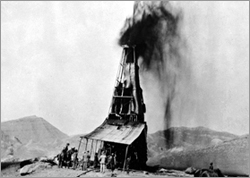 The first big gusher in the Middle East was the discovery well in 1908 at Masjed-e-Soleiman (Masjid-i-Suleiman) field in the Meidan Naftoon region of Persia. The well was drilled by William Knox D'Arcy, an Englishman who had made a fortune mining gold in Australia. He managed to secure an exclusive concession for oil exploration in most of what is now modern Iran from the Shah of Tehran in 1901, and began drilling in the southern part of the country in 1903. His big strike came shortly after 4:00 AM on the morning of May 26, 1908 when the Masjed Soleyman No. 1 well blew out at about 1180 feet, sending a column of oil 50 feet above the drilling rig. The following day, Well No. 1 tested at a rate of about 297 barrels of oil a day. The next year D'Arcy organized his holdings into the Anglo-Persian Oil Company, which later became the Anglo-Iranian Oil Company (AIOC), a predecessor of British Petroleum (BP). The first big gusher in the Middle East was the discovery well in 1908 at Masjed-e-Soleiman (Masjid-i-Suleiman) field in the Meidan Naftoon region of Persia. The well was drilled by William Knox D'Arcy, an Englishman who had made a fortune mining gold in Australia. He managed to secure an exclusive concession for oil exploration in most of what is now modern Iran from the Shah of Tehran in 1901, and began drilling in the southern part of the country in 1903. His big strike came shortly after 4:00 AM on the morning of May 26, 1908 when the Masjed Soleyman No. 1 well blew out at about 1180 feet, sending a column of oil 50 feet above the drilling rig. The following day, Well No. 1 tested at a rate of about 297 barrels of oil a day. The next year D'Arcy organized his holdings into the Anglo-Persian Oil Company, which later became the Anglo-Iranian Oil Company (AIOC), a predecessor of British Petroleum (BP).
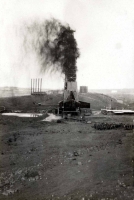 Another big gusher in the Middle East was the 1927 discovery well of the Baba Gurgur field near Kirkuk, Iraq. The field is known for the Eternal Fire - a gas seep that has burned for at least 4,000 years. The discovery well was drilled by the Turkish Petroleum Company on Kurdish lands about six miles from Kirkuk. The well blew out just past 3:00 AM on morning of October 15th at 3:00 AM at a depth of about 1500 feet, and began spraying the countryside with oil. Seven hundred tribesmen were recruited to build a levee around the well to contain the oil, which created the river of oil shown in the photo below. The well was finally brought under control after eight and a half days, flowing at a rate of 95,000 barrels of oil a day. Another big gusher in the Middle East was the 1927 discovery well of the Baba Gurgur field near Kirkuk, Iraq. The field is known for the Eternal Fire - a gas seep that has burned for at least 4,000 years. The discovery well was drilled by the Turkish Petroleum Company on Kurdish lands about six miles from Kirkuk. The well blew out just past 3:00 AM on morning of October 15th at 3:00 AM at a depth of about 1500 feet, and began spraying the countryside with oil. Seven hundred tribesmen were recruited to build a levee around the well to contain the oil, which created the river of oil shown in the photo below. The well was finally brought under control after eight and a half days, flowing at a rate of 95,000 barrels of oil a day.
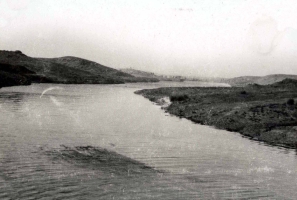
Pennsylvania Gushers
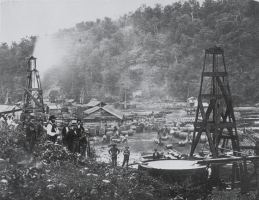
Although the Drake well at Oil Creek in Verango County, Pennsylvania, which flowed a mere 10-25 barrels a day in 1859, was no gusher, several gushers were drilled during the oil boom that followed. Capt. A.B. Funk in May of 1861 drilled one nicknamed the "Fountain". After the flow was controlled, the Fountain produced 300 barrels a day for six months, until the well bore became choked with paraffin. Then on October 20, 1861, Thomas and William Phillips were drilling their second well at the Tarr farm on Oil Creek when they hit an oil sand, and the well spouted over the top with a flow of 4,000 barrels a day. There was so much oil that it ran into Oil Creek, with an oil skim covering the surface of the Allegheny River at Emlenton, fifty miles downstream. The oil flowed unchecked for three or four days, and the well was unsurpassed for over twenty years. The Phillips No. 2 in 1862, when it was still producing over three-thousand barrels a day, is visible on the right side of the above thumbnail.
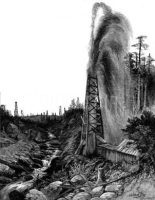 Thorn Creek field in Butler County, Pennsylvania was known for some of the most spectacular gushers in the Appalachians. The first big well was drilled in 1884 by the Phillips Brothers on the Bartlett farm. Their well came in on August 31 at a respectable 500 barrels a day. When they deepened it on September 3, the flow increased to 1,300 barrels, and eventually reached 4,200 barrels a day with continued deepening - matching their earlier success two decades earlier at the Tarr farm. A couple of months later, and only 360 feet away on the next lease, Hezekiah Christie on October 15 drilled a gusher that produced 7,000 barrels a day for several days. The New York Times called the Christie well the greatest gusher the country had ever seen. However, just a few days later, Colonel S.P. Armstrong drilled his No. 2 well at the Marshall Farm, 400 feet south of the Phillips well. At first, the well was considered a failure, with no show of oil gas, but after shooting the well with forty quarts of nitro-glycerine on October 27, it spewed 8,000 barrels the first day. The line drawing on the left from 1886 shows a Pennsylvania gusher, probably one of the Thorn Creek wells. Thorn Creek field in Butler County, Pennsylvania was known for some of the most spectacular gushers in the Appalachians. The first big well was drilled in 1884 by the Phillips Brothers on the Bartlett farm. Their well came in on August 31 at a respectable 500 barrels a day. When they deepened it on September 3, the flow increased to 1,300 barrels, and eventually reached 4,200 barrels a day with continued deepening - matching their earlier success two decades earlier at the Tarr farm. A couple of months later, and only 360 feet away on the next lease, Hezekiah Christie on October 15 drilled a gusher that produced 7,000 barrels a day for several days. The New York Times called the Christie well the greatest gusher the country had ever seen. However, just a few days later, Colonel S.P. Armstrong drilled his No. 2 well at the Marshall Farm, 400 feet south of the Phillips well. At first, the well was considered a failure, with no show of oil gas, but after shooting the well with forty quarts of nitro-glycerine on October 27, it spewed 8,000 barrels the first day. The line drawing on the left from 1886 shows a Pennsylvania gusher, probably one of the Thorn Creek wells.
Texas Gushers
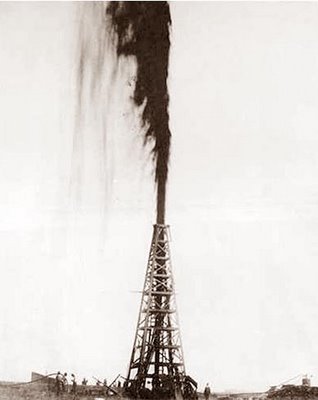 Though not a California well, the Spindletop gusher, which blew out on January 10, 1901 near Beaumont in East Texas, had a great impact on the California oil industry. Spindletop was not the first nor the biggest gusher - the Adams Canyon, Shamrock and Blue Goose gushers of California were earlier and the Lakeview gusher was bigger. However, Spindletop was certainly one of the great gushers of all time, and, most important, it heralded the birth of the Texas oil industry. Though not a California well, the Spindletop gusher, which blew out on January 10, 1901 near Beaumont in East Texas, had a great impact on the California oil industry. Spindletop was not the first nor the biggest gusher - the Adams Canyon, Shamrock and Blue Goose gushers of California were earlier and the Lakeview gusher was bigger. However, Spindletop was certainly one of the great gushers of all time, and, most important, it heralded the birth of the Texas oil industry.
Spindletop blew in when Anthony Lucas, a Louisiana mining engineer, drilled a well to 1,020 feet on a lease owned by Texas businessman and amateur geologist Patillo "Bud Higgins". Lucas placed his well on a low hill that he and Higgins thought might be a salt dome, and when the ground began to tremble on that fateful day in January and a great spout of oil exploded into the air, it confirmed their belief that oil accumulated around salt domes. The well produced an astounding 800,000 barrels of oil in just 8 days, but quickly dropped off enough so that by January 19 Lucas and his crew were able to cap it and gain control of it.
By September, there were at least six wells producing from the crest of Spindletop, with many more on the way. The field produced over 17 million barrel of oil in 1902, but production declined rapidly, and dropped to 10,000 barrels/day by the start of 1904. However, oil was found on the flanks of the dome in 1925, which led to another surge in drilling that pushed production to an all time high of 27 million barrels in 1927. Total production from the field in 1985 stood at 153 million barrels.
Please see The Handbook of Texas Online for more info on Spindletop.
 The East Texas oil field, the largest field in the contiguous United States, was discovered in 1930, when a 69-year old "wildcatter" named Columbus (Dad) Joiner bought hundreds of East Texas oil leases and recruited self-proclaimed geologist Doc Lloyd to find him a well site. After drilling two "dusters" on the farm of widow Daisy Bradford, Joiner was near the end of his finances in May 1929 when he began drilling his third well on the farm, the Daisy Bradford No. 3 (shown on the right), with a makeshift rig and a crew of farm hands in country where experts said no oil existed . The East Texas oil field, the largest field in the contiguous United States, was discovered in 1930, when a 69-year old "wildcatter" named Columbus (Dad) Joiner bought hundreds of East Texas oil leases and recruited self-proclaimed geologist Doc Lloyd to find him a well site. After drilling two "dusters" on the farm of widow Daisy Bradford, Joiner was near the end of his finances in May 1929 when he began drilling his third well on the farm, the Daisy Bradford No. 3 (shown on the right), with a makeshift rig and a crew of farm hands in country where experts said no oil existed .
The crew pulled an oil-soaked core out of the Woodbine Sand from a depth of 3,536 feet on September 5, 1930, but Joiner, who couldn't resist a good show, delayed further drilling until October 3, when a crowd of 8,000 people gathered at the Bradford farm to see Dad Joiner hit oil. However, many in the crowd left disappointed as the day wore on and nothing happened. It was evening before the well finally came in at 3,592 feet, spouting oil over the top at a rate of 300 barrels a day. Joiner, who had oversold shares to finance his operation, became embroiled in lawsuits, and ended up selling out to H.L. Hunt of Hunt Oil. Although the six-billion barrel oil field he discovered made many men wealthy, Dad Joiner was not one of them.
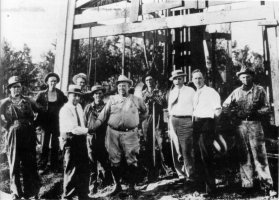
Dad Joiner (wearing tie and hat) shakes the hand
of geologist Doc Lloyd in front of the Daisy Bradford No. 3.
H.L. Hunt (with cigar and hat) stands to the right of Lloyd.
Oklahoma Gushers
George B. Keeler, a fur trader who came to the Oklahoma Indian Territory in 1871 to work at a trading post, first noticed a sheen of oil on the Caney River back in 1875 and suspected that it might indicate an oil seep. He set up a trading post with William Johnstone on the south bank of the river, just a short distance from the future site of Bartlesville. Two decades later, when Bartlesville had grown into a full-fledged town, Keeler and Johnstone managed to obtain a lease near their old trading post from the Cherokee Nation and recruited the Cudahy Oil Company to drill them a well.

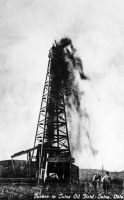 The well, which was named the Nellie Johnstone No. 1 after William's grandaughter, was drilled in the Spring of 1897 to a depth of 1,320 feet, where oil shows were found, but little else. They decided to "shoot" the hole and, on March 25th, with spectators on hand, Keeler's step-daughter Jennie Cass dropped a "go-devil", a torpedo of nitroglycerin, down the well. When the charge went off, oil spouted over the top to cheers from the crowd, and the Oklahoma oil boom was on. The well was completed three weeks later, but transportation was an issue, and the well remained capped for two years until the railroad came into town. The first barrel of oil shipped in May, 1900, and the Nellie Johnstone produced a little more than 100,000 barrels before being plugged and abandoned in 1948.
The well, which was named the Nellie Johnstone No. 1 after William's grandaughter, was drilled in the Spring of 1897 to a depth of 1,320 feet, where oil shows were found, but little else. They decided to "shoot" the hole and, on March 25th, with spectators on hand, Keeler's step-daughter Jennie Cass dropped a "go-devil", a torpedo of nitroglycerin, down the well. When the charge went off, oil spouted over the top to cheers from the crowd, and the Oklahoma oil boom was on. The well was completed three weeks later, but transportation was an issue, and the well remained capped for two years until the railroad came into town. The first barrel of oil shipped in May, 1900, and the Nellie Johnstone produced a little more than 100,000 barrels before being plugged and abandoned in 1948.
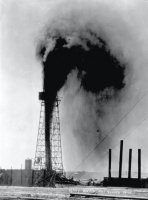 The "Wild Mary Sudik" was a famous Oklahoma gusher in the Oklahoma City field that received national attention when it was drilled in 1930 by the Indian Territory Illuminating Oil Company on the Vince and Mary Sudik farm. The well blew out when the drilling crew failed to properly weight the mud in the hole on March 26, 1930, initially flowing 200 million cubic feet of gas a day. Slowly, the gas turned to oil, reaching a peak rate of 72,000 barrels a day. The nation watched, or rather listened, for the next eleven days, as Floyd Gibbons of NBC radio broadcast regular reports. After two unsuccessful attempts, the Wild Mary was finally capped on April 6. The "Wild Mary Sudik" was a famous Oklahoma gusher in the Oklahoma City field that received national attention when it was drilled in 1930 by the Indian Territory Illuminating Oil Company on the Vince and Mary Sudik farm. The well blew out when the drilling crew failed to properly weight the mud in the hole on March 26, 1930, initially flowing 200 million cubic feet of gas a day. Slowly, the gas turned to oil, reaching a peak rate of 72,000 barrels a day. The nation watched, or rather listened, for the next eleven days, as Floyd Gibbons of NBC radio broadcast regular reports. After two unsuccessful attempts, the Wild Mary was finally capped on April 6.
A fairly recent Oklahoma gusher that caught a lot of attention was the Amarex Pennington-Thompson #1, which blew out on September 9, 1981 in Roger Mills County at the height of the 1980s oil boom. The rig, which was the TRG 131, caught fire two days later, and in a matter of only 13 minutes the entire north side of the derrick melted, causing the 131 to collapse into the mud pit. Photographer Charles Keevert captured it all in an incredible series of four photographs (shown below) that have been published many times over.
Gulf of Mexico Gushers
 A Deepwater Horizon semi-submersible drilling rig near Rigel gas field in the Gulf of Mexico blew out On April 20, 2010, caught fire, burned for two days, and sank in 4,992 feet of water. This rig was owned by Transocean Ltd. and was on contract to British Petroleum to drill the Macondo prospect in Mississippi Canyon Block 252. Eleven men were killed, and another 115 men and women were evacuated, with 17 injured among the group. A Deepwater Horizon semi-submersible drilling rig near Rigel gas field in the Gulf of Mexico blew out On April 20, 2010, caught fire, burned for two days, and sank in 4,992 feet of water. This rig was owned by Transocean Ltd. and was on contract to British Petroleum to drill the Macondo prospect in Mississippi Canyon Block 252. Eleven men were killed, and another 115 men and women were evacuated, with 17 injured among the group.
Transocean is the worlds largest offshore drilling contractor, and this rig was contracted through 2013 to BP at a cost of about $500,000/day. However, with helicopters, support vessels, and other services, the cost to BP is probably closer to $1,000,000/day. The cost to build a rig like this was about $350,000,000 in 2001, and it would probably cost double that to replace it today.
This type of rig is called semi-submersible, and it is capable of working in water depths up to 10,000 feet. It is a floating rig that does not use anchors, which are too costly, and not strong enough anyway to restrain such a heavy floating structure. Instead a computer system using satellite positioning controls thrusters that keep the rig at all times within a few feet of its intended target.
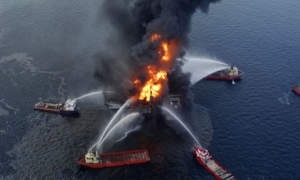 This prospect was drilled as a delineation well to define the outlines of a known oil and gas accumulation, and having confirmed the presence of hydrocarbons, BP was in the process of capping the well, probably intending to return at a future date to develop the find. They had just finished cementing steel casing in place when the blowout took place, resulting in an explosion with flames 200 to 300 feet high that were visible as far as 35 miles away. This prospect was drilled as a delineation well to define the outlines of a known oil and gas accumulation, and having confirmed the presence of hydrocarbons, BP was in the process of capping the well, probably intending to return at a future date to develop the find. They had just finished cementing steel casing in place when the blowout took place, resulting in an explosion with flames 200 to 300 feet high that were visible as far as 35 miles away.
The well was finally controlled on July 15, 2010 by lowering a 125-ton steel containment dome over the spot where most of the oil was leaking from the sea floor. This succeeded in capturing most, but not all, of the oil. Interstingly this same technique, but with a box made of wooden timbers, had been attempted as one of the efforts to kill the Lakeview Gusher back in 1910.
A "static kill" on August 4, where heavy fluids where injected into the wellhead, followed by cement, effectively sealed off the well. However, it was not until a relief well that had started on May 2 finally intersected the well bore on September 16 and pumped in cement from below, that the well was officially declared dead on June 19.
All told, the Macondo well spilled an estimated 4.9 million barrels (185 million gallons) of oil, with a peak flow rate of about 62,000 barrels/day. By comparison, the Lakerview Gusher spilled 9.4 million barrels, with a peak flow rate of possibly 125,000 barrels/day. Thus, the Macondo blowout was big, but the Lakeview twice as big.
Latin American gushers
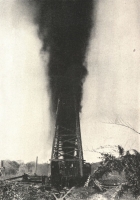 Although Spindletop was called the greatest gusher of all time when it blew out in 1901, the Lakeview Gusher of 1909 was bigger, and bigger still was the Cerro Azul No. 4 - a gusher that blew out on February 10, 1916 near Tampico in the state of Veracruz, Mexico. This well was drilled in the Golden Lane trend by the Mexican Petroleum Company, which was headed by Edward Doheny, who had discovered the Los Angeles City oil field in 1892 by hand digging a well on a tar seep. Doheny had also drilled the Mexican El Ebano well in 1901, which is sometimes called a gusher, even though it never went over the top. However, it was siginficant as Mexico's first commercial oil strike. Although Spindletop was called the greatest gusher of all time when it blew out in 1901, the Lakeview Gusher of 1909 was bigger, and bigger still was the Cerro Azul No. 4 - a gusher that blew out on February 10, 1916 near Tampico in the state of Veracruz, Mexico. This well was drilled in the Golden Lane trend by the Mexican Petroleum Company, which was headed by Edward Doheny, who had discovered the Los Angeles City oil field in 1892 by hand digging a well on a tar seep. Doheny had also drilled the Mexican El Ebano well in 1901, which is sometimes called a gusher, even though it never went over the top. However, it was siginficant as Mexico's first commercial oil strike.
The Cerro Azul No. 4 well was drilled by Doheney in the dense Veracruz jungles at Cerro Azul, or the "Blue Hill", an ancient (Cretaceous) limestone atoll that Doheny's men had to build fifty kilometers of dirt road to reach. Drilling began in 1915, and drilled to cap rock. Then, after a lull, drilling resumed in February, 1916.
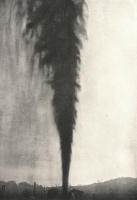 The company expected a big well and considerable preparations were made in advance to deal with a gusher. The well took a gas kick on February 9 that forced water out of the hole and presaged what was to come. Work resumed the next day, until a deep rumbling began, and the ground began to shake. Suddenly, the drill string shot out of the hole and the upper part of the derrick was reduced to tinder. At first only gas flowed, but seven hours later came the oil, which spouted nearly 600 feet into the air. The flow was first gauged on February 15 at 152,000 barrels of oil a day, and continued to increase. On February 19, the day the well was capped and brought under control, it blew 260,858 barrels in 24 hours. Total production by December 31, 1921 was 57,082,755 barrels of oil and the well was still producing. The company expected a big well and considerable preparations were made in advance to deal with a gusher. The well took a gas kick on February 9 that forced water out of the hole and presaged what was to come. Work resumed the next day, until a deep rumbling began, and the ground began to shake. Suddenly, the drill string shot out of the hole and the upper part of the derrick was reduced to tinder. At first only gas flowed, but seven hours later came the oil, which spouted nearly 600 feet into the air. The flow was first gauged on February 15 at 152,000 barrels of oil a day, and continued to increase. On February 19, the day the well was capped and brought under control, it blew 260,858 barrels in 24 hours. Total production by December 31, 1921 was 57,082,755 barrels of oil and the well was still producing.
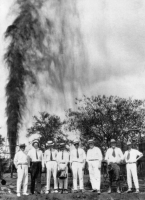 The big gusher of South America was the Barroso No. 2 well in Cabimas, Venezuela, on the eastern shore of Lake Maracaibo. Drilled by a subsidiary of Shell Oil, it blew out at a depth of 1,500 feet on December 14, 1922 with an initial flow of about 2,000 barrels of oil per day and a large amount of gas. Yet the flow increased rapidly, until it reached 100,000 barrels, destroying the derrick, and creating a column of oil 200 feet high. The well gushed for nine days, covering the countryside with nearly a million barrels of before oil, before experts from the United States capped it. The big gusher of South America was the Barroso No. 2 well in Cabimas, Venezuela, on the eastern shore of Lake Maracaibo. Drilled by a subsidiary of Shell Oil, it blew out at a depth of 1,500 feet on December 14, 1922 with an initial flow of about 2,000 barrels of oil per day and a large amount of gas. Yet the flow increased rapidly, until it reached 100,000 barrels, destroying the derrick, and creating a column of oil 200 feet high. The well gushed for nine days, covering the countryside with nearly a million barrels of before oil, before experts from the United States capped it.
|

|
 Thorn Creek field in Butler County, Pennsylvania was known for some of the most spectacular gushers in the Appalachians. The first big well was drilled in 1884 by the Phillips Brothers on the Bartlett farm. Their well came in on August 31 at a respectable 500 barrels a day. When they deepened it on September 3, the flow increased to 1,300 barrels, and eventually reached 4,200 barrels a day with continued deepening - matching their earlier success two decades earlier at the Tarr farm. A couple of months later, and only 360 feet away on the next lease, Hezekiah Christie on October 15 drilled a gusher that produced 7,000 barrels a day for several days. The New York Times called the Christie well the greatest gusher the country had ever seen. However, just a few days later, Colonel S.P. Armstrong drilled his No. 2 well at the Marshall Farm, 400 feet south of the Phillips well. At first, the well was considered a failure, with no show of oil gas, but after shooting the well with forty quarts of nitro-glycerine on October 27, it spewed 8,000 barrels the first day. The line drawing on the left from 1886 shows a Pennsylvania gusher, probably one of the Thorn Creek wells.
Thorn Creek field in Butler County, Pennsylvania was known for some of the most spectacular gushers in the Appalachians. The first big well was drilled in 1884 by the Phillips Brothers on the Bartlett farm. Their well came in on August 31 at a respectable 500 barrels a day. When they deepened it on September 3, the flow increased to 1,300 barrels, and eventually reached 4,200 barrels a day with continued deepening - matching their earlier success two decades earlier at the Tarr farm. A couple of months later, and only 360 feet away on the next lease, Hezekiah Christie on October 15 drilled a gusher that produced 7,000 barrels a day for several days. The New York Times called the Christie well the greatest gusher the country had ever seen. However, just a few days later, Colonel S.P. Armstrong drilled his No. 2 well at the Marshall Farm, 400 feet south of the Phillips well. At first, the well was considered a failure, with no show of oil gas, but after shooting the well with forty quarts of nitro-glycerine on October 27, it spewed 8,000 barrels the first day. The line drawing on the left from 1886 shows a Pennsylvania gusher, probably one of the Thorn Creek wells.














